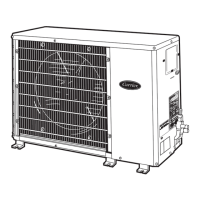35
REFRIGERANT LINES
General Guides:
1. Refrigerant lines can access the ceiling--suspended unit from
either the top--right or rear--right when facing the unit.
2. Refrigerant lines should not be buried in the ground. If it is
necessary to bury the lines, not more than 36--in (914 mm)
should be buried. Provide a minimum 6--in (152 mm)
vertical rise to the service valves to prevent refrigerant
migration.
3. On cooling only units, the suction line must be insulated.
On heat pumps, insulate both lines. Use a minimum of
1/2--in. (12.7 mm) thick insulation. Closed--cell insulation is
recommended in all long--line applications.
4. Special consideration should be given to isolating
interconnecting tubing from the building structure. Isolate
the tubing so that vibration or noise is not transmitted into
the structure.
NOTE: Since the same outdoor unit can be matched with different
types of indoor units, it may not have enough refrigerant charge.
Refer to the Physical Data tables in this document to determine if
additional charge is required.
Long Line Applications:
The following table indicates the maximum line lengths that can be
used with the high wall systems:
Item
Max Length Allowed
ft (m)
Total Piping 200 (61)
Max Lift (fan coil above) 65 (20)
Max Drop (fan coil below) 200 (61)
For line lengths over 25 ft (7.6 m), .6 oz of charge should be added
for each additional foot up to the maximum allowed.
For line lengths over 80 ft (24.4 m), certain accessories and
adjustments to the piston sizes are also required.
Refer to the Duct Free Split Systems Long Line Guide for
additional information.
CONTROLS
Ceiling--suspended fan coil units have a relay board which controls
system operation in response to the room thermostat.
The 40QAC/QAQ unit has 4 operating modes:
S Fan Only
S Auto (heat pump models only)
S Heating (heat pump models only)
S Cooling
FAN ONLY -- In Fan Only mode, the system filters and circulates
the room air without changing the room air temperature.
AUTO -- In Auto mode, the system will automatically select one of
the following operating modes: cooling, or heating depending on
the selected thermostat set point.
HEATING -- In the Heating mode, the system heats and filters
room air.
COOLING -- In Cooling mode, the system cools, dries and filters
room air.
SEQUENCE OF OPERATION
Increased demand for cooling
(heat pump systems)
1. When the room thermostat senses a demand for cooling, the
fan coil relay board is energized and the indoor fan will start
in the selected speed (if it is not already operating).
2. The reversing valve is energized at all times when in
cooling mode.
3. The internal condensate pump (if so equipped) runs
whenever the reversing valve is energized. The internal
condensate pump (if so equipped) runs whenever there is a
demand for cooling.
4. As long as the condensate float switch and freeze protection
thermostat are closed, the cooling relays in the fan coil unit
will close. This energizes the compressor and outdoor fan in
the outdoor unit. The compressor will continue to operate
until the room thermostat is satisfied.
5. When the cooling demand is satisfied, the compressor and
outdoor fan will stop. If the system is in Auto. mode, the
indoor fan will stop with the compressor. If the unit has the
accessory ventilation kit, the ventilation fan will operate
whenever the indoor fan is set for medium or high speed.
Increased demand for heating
(heat pump systems)
1. When the room thermostat senses a demand for heating, the
fan coil relay board is energized .
2. The indoor fan will start in the selected speed (if it is not
already operating). The reversing valve will not be
energized. The internal condensate pump (if supplied) and
freeze protection thermostat are not operated during heating
operation.
3. The control relay closes, and the compressor and outdoor
fan are energized through the defrost and the defrost timer
runs.
4. Once every 90 minutes (the factory default setting) of the
compressor run time, the DFB (defrost board) logic checks
the defrost thermostat (DFT). If the DFT is open, the unit
continues in heating operation. If the DFT is closed, the
DFB switches the unit to defrost mode. The timing on the
DFB may be set at either 30, 50 or 90 minutes.
Defrost
The DFB energizes the RVS (reversing valve solenoid), and the
reversing valve switches to the cooling position. The relay on the
DFB opens and the outdoor fan stops. The contact on the DFB is
also energized, which in turn energizes the defrost relay on the fan
coil relay board, turns off the electric heater and stops the indoor
fan. The DFB logic checks the 10--minute defrost timer and the
DFT. If the DFT opens in less than 10 minutes, the defrost board
switches the unit back to normal heating operation. If the DFT
remains closed the DFB switches the unit back to heating operation
after 10 minutes. When the DFB changes back to heating mode,
the RVR (reversing valve relay) is deenergized and the reversing
valve switches back to heating operation. Both the outdoor and
indoor fans come back on, and if necessary, the electric heater also
turns on.
40QAC/38HDR -- 40QAQ/38QR

